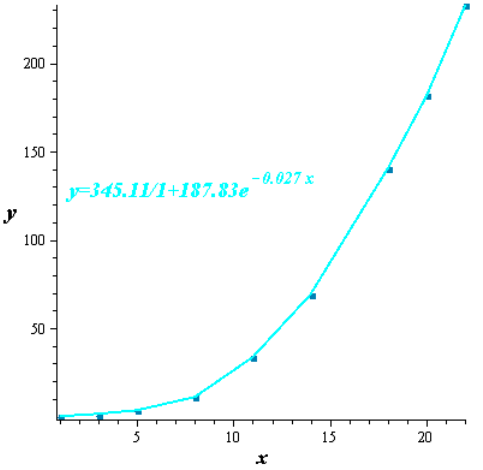
Concept explainers
(a)
To find: The logistic model from the given data.
(a)
Answer to Problem 10AYU
The logistic model of the given data is
Explanation of Solution
Given:
The given data is shown in Table 1
Table 1
| Years x | Subscribers1000, |
| 1 | 0.34 |
| 3 | 1.23 |
| 5 | 3.51 |
| 8 | 11.03 |
| 11 | 33.76 |
| 14 | 69.21 |
| 18 | 140.77 |
| 20 | 182.14 |
| 22 | 233.00 |
Calculation:
Consider the users as the independent variable and then a

Figure 1
Consider the logistic model with the help of graphing utility as,
(b)
To find: The scatter plot for the logistic model.
(b)
Answer to Problem 10AYU
The scatter plot is shown in Figure 2
Explanation of Solution
Consider the logistic model is,
Consider the scatter plot from the given data is shown in Figure 2

Figure 2
(c)
To find: The predicted capacity of US cell phone subscribers.
(c)
Answer to Problem 10AYU
The capacity is
Explanation of Solution
Consider the logistic model is,
The predicted capacity is obtained by using
That is
(d)
To find: The predicted number of cell phone users at the end of 2009 from the model found in part (b).
(d)
Answer to Problem 10AYU
The predicted number of cell phone users is
Explanation of Solution
Consider the logistic model is,
Consider the number of years passed is 25. Then,
(e)
To find: The comparison of the answer in part (d) with the answers of example 1 part (e) and explain the different predictions.
(e)
Answer to Problem 10AYU
The model is better prediction of the future in terms of the cell phone users as it is far more than the population.
Explanation of Solution
Consider the number of users in example 1 is 1247 million that is far more than the population of the country so the users is at the par of the population is the prediction for the future users.
Hence, the model is better prediction of the future in terms of the cell phone users.
Chapter 5 Solutions
Precalculus
Additional Math Textbook Solutions
Calculus: Early Transcendentals (2nd Edition)
College Algebra with Modeling & Visualization (5th Edition)
Algebra and Trigonometry (6th Edition)
Elementary Statistics
Elementary Statistics (13th Edition)
- A function is defined on the interval (-π/2,π/2) by this multipart rule: if -π/2 < x < 0 f(x) = a if x=0 31-tan x +31-cot x if 0 < x < π/2 Here, a and b are constants. Find a and b so that the function f(x) is continuous at x=0. a= b= 3arrow_forwardUse the definition of continuity and the properties of limits to show that the function is continuous at the given number a. f(x) = (x + 4x4) 5, a = -1 lim f(x) X--1 = lim x+4x X--1 lim X-1 4 x+4x 5 ))" 5 )) by the power law by the sum law lim (x) + lim X--1 4 4x X-1 -(0,00+( Find f(-1). f(-1)=243 lim (x) + -1 +4 35 4 ([ ) lim (x4) 5 x-1 Thus, by the definition of continuity, f is continuous at a = -1. by the multiple constant law by the direct substitution propertyarrow_forward1. Compute Lo F⚫dr, where and C is defined by F(x, y) = (x² + y)i + (y − x)j r(t) = (12t)i + (1 − 4t + 4t²)j from the point (1, 1) to the origin.arrow_forward
- 2. Consider the vector force: F(x, y, z) = 2xye²i + (x²e² + y)j + (x²ye² — z)k. (A) [80%] Show that F satisfies the conditions for a conservative vector field, and find a potential function (x, y, z) for F. Remark: To find o, you must use the method explained in the lecture. (B) [20%] Use the Fundamental Theorem for Line Integrals to compute the work done by F on an object moves along any path from (0,1,2) to (2, 1, -8).arrow_forwardhelp pleasearrow_forwardIn each of Problems 1 through 4, draw a direction field for the given differential equation. Based on the direction field, determine the behavior of y as t → ∞. If this behavior depends on the initial value of y at t = 0, describe the dependency.1. y′ = 3 − 2yarrow_forward
- B 2- The figure gives four points and some corresponding rays in the xy-plane. Which of the following is true? A B Angle COB is in standard position with initial ray OB and terminal ray OC. Angle COB is in standard position with initial ray OC and terminal ray OB. C Angle DOB is in standard position with initial ray OB and terminal ray OD. D Angle DOB is in standard position with initial ray OD and terminal ray OB.arrow_forwardtemperature in degrees Fahrenheit, n hours since midnight. 5. The temperature was recorded at several times during the day. Function T gives the Here is a graph for this function. To 29uis a. Describe the overall trend of temperature throughout the day. temperature (Fahrenheit) 40 50 50 60 60 70 5 10 15 20 25 time of day b. Based on the graph, did the temperature change more quickly between 10:00 a.m. and noon, or between 8:00 p.m. and 10:00 p.m.? Explain how you know. (From Unit 4, Lesson 7.) 6. Explain why this graph does not represent a function. (From Unit 4, Lesson 8.)arrow_forwardFind the area of the shaded region. (a) 5- y 3 2- (1,4) (5,0) 1 3 4 5 6 (b) 3 y 2 Decide whether the problem can be solved using precalculus, or whether calculus is required. If the problem can be solved using precalculus, solve it. If the problem seems to require calculus, use a graphical or numerical approach to estimate the solution. STEP 1: Consider the figure in part (a). Since this region is simply a triangle, you may use precalculus methods to solve this part of the problem. First determine the height of the triangle and the length of the triangle's base. height 4 units units base 5 STEP 2: Compute the area of the triangle by employing a formula from precalculus, thus finding the area of the shaded region in part (a). 10 square units STEP 3: Consider the figure in part (b). Since this region is defined by a complicated curve, the problem seems to require calculus. Find an approximation of the shaded region by using a graphical approach. (Hint: Treat the shaded regi as…arrow_forward
- Solve this differential equation: dy 0.05y(900 - y) dt y(0) = 2 y(t) =arrow_forwardSuppose that you are holding your toy submarine under the water. You release it and it begins to ascend. The graph models the depth of the submarine as a function of time. What is the domain and range of the function in the graph? 1- t (time) 1 2 4/5 6 7 8 -2 -3 456700 -4 -5 -6 -7 d (depth) -8 D: 00 t≤ R:arrow_forward0 5 -1 2 1 N = 1 to x = 3 Based on the graph above, estimate to one decimal place the average rate of change from x =arrow_forwardarrow_back_iosSEE MORE QUESTIONSarrow_forward_ios
 Calculus: Early TranscendentalsCalculusISBN:9781285741550Author:James StewartPublisher:Cengage Learning
Calculus: Early TranscendentalsCalculusISBN:9781285741550Author:James StewartPublisher:Cengage Learning Thomas' Calculus (14th Edition)CalculusISBN:9780134438986Author:Joel R. Hass, Christopher E. Heil, Maurice D. WeirPublisher:PEARSON
Thomas' Calculus (14th Edition)CalculusISBN:9780134438986Author:Joel R. Hass, Christopher E. Heil, Maurice D. WeirPublisher:PEARSON Calculus: Early Transcendentals (3rd Edition)CalculusISBN:9780134763644Author:William L. Briggs, Lyle Cochran, Bernard Gillett, Eric SchulzPublisher:PEARSON
Calculus: Early Transcendentals (3rd Edition)CalculusISBN:9780134763644Author:William L. Briggs, Lyle Cochran, Bernard Gillett, Eric SchulzPublisher:PEARSON Calculus: Early TranscendentalsCalculusISBN:9781319050740Author:Jon Rogawski, Colin Adams, Robert FranzosaPublisher:W. H. Freeman
Calculus: Early TranscendentalsCalculusISBN:9781319050740Author:Jon Rogawski, Colin Adams, Robert FranzosaPublisher:W. H. Freeman
 Calculus: Early Transcendental FunctionsCalculusISBN:9781337552516Author:Ron Larson, Bruce H. EdwardsPublisher:Cengage Learning
Calculus: Early Transcendental FunctionsCalculusISBN:9781337552516Author:Ron Larson, Bruce H. EdwardsPublisher:Cengage Learning





